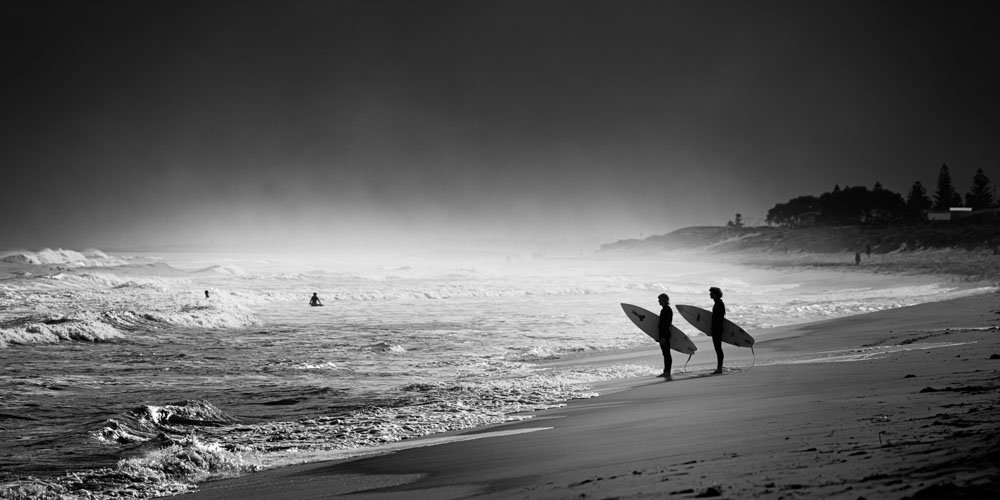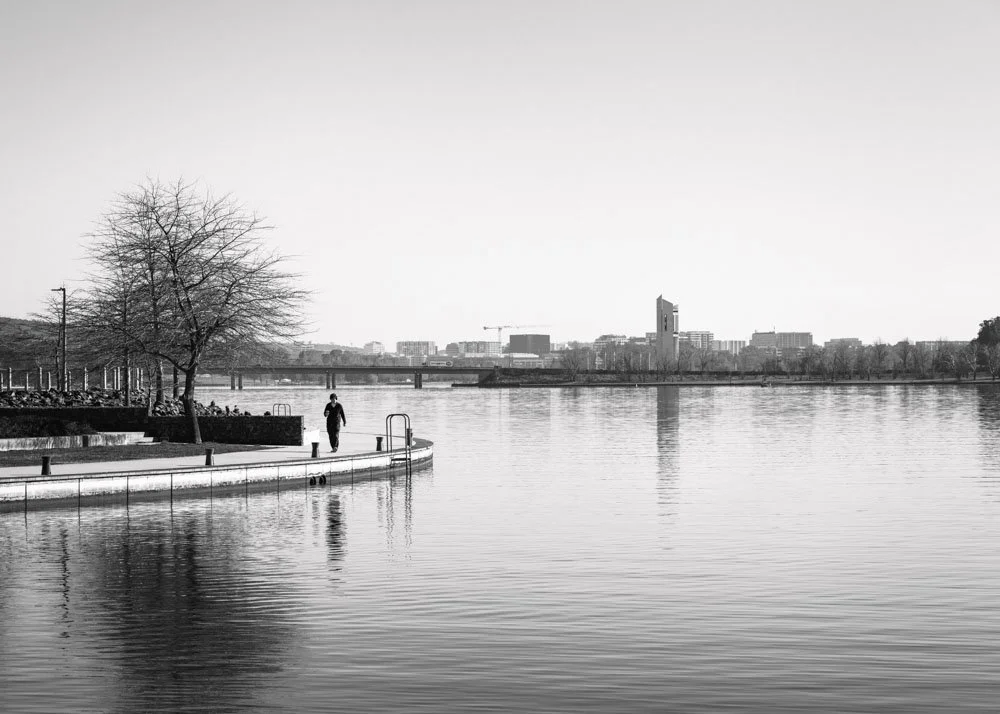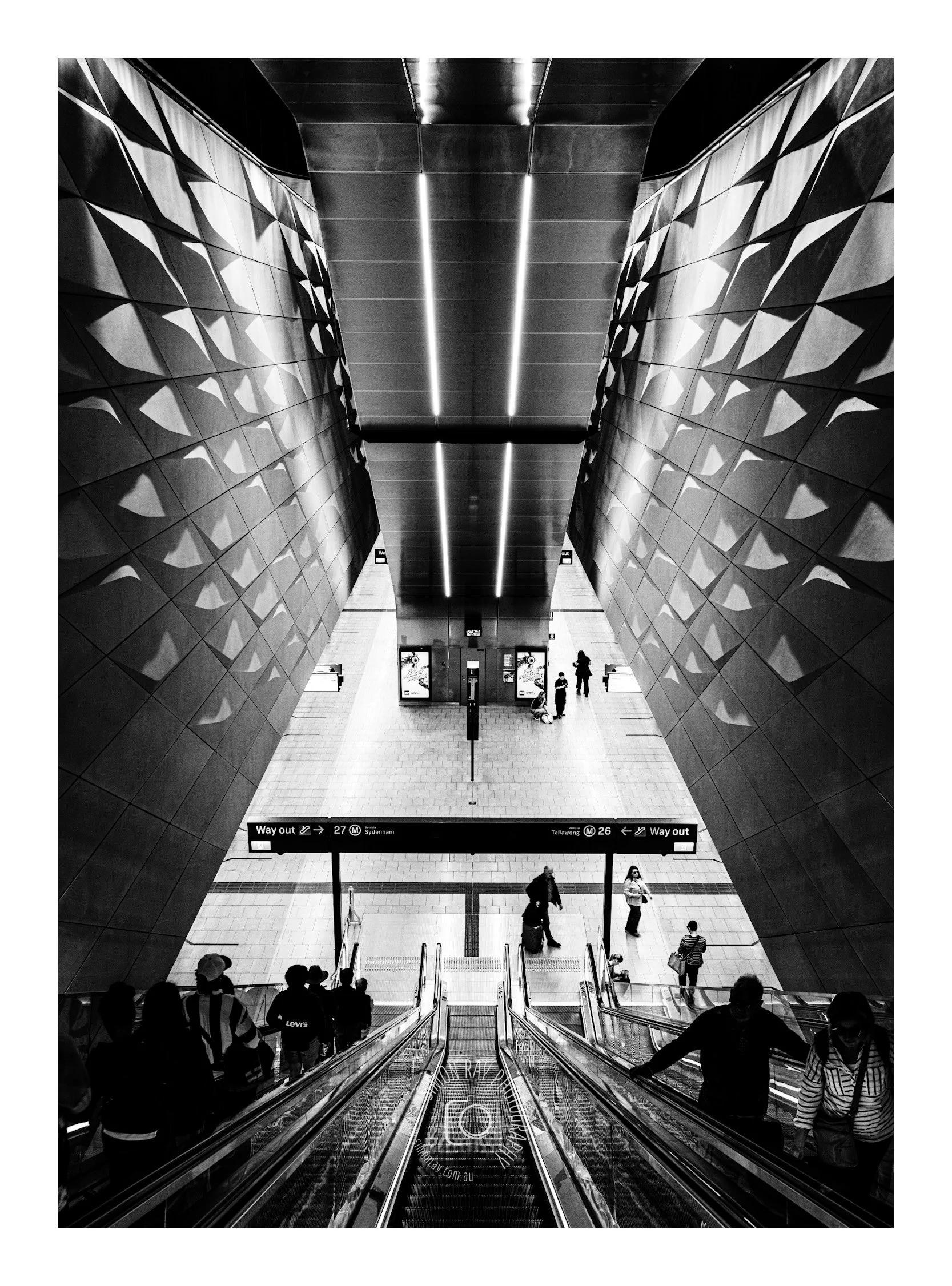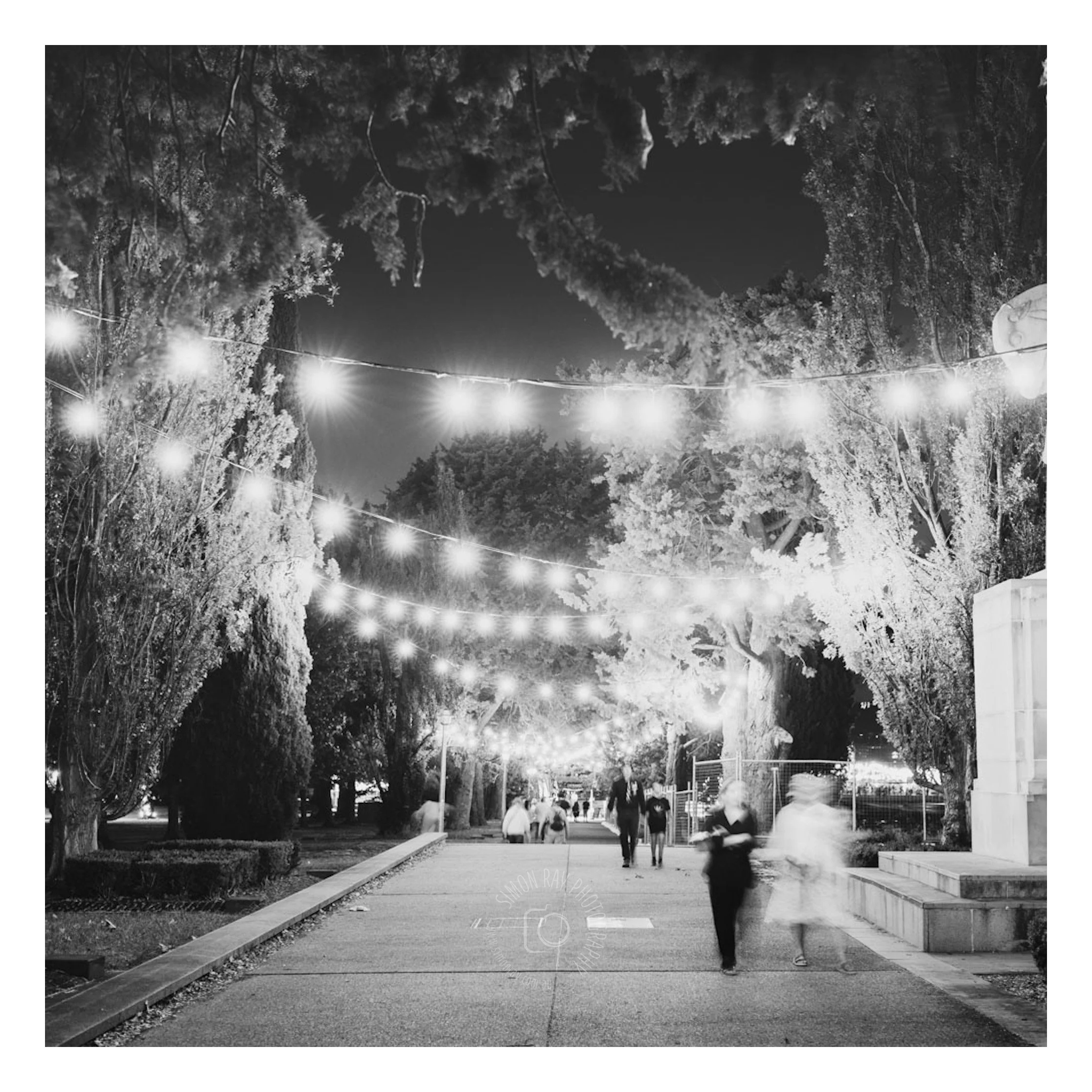Appreciating the Magic of Black and White
Black and white photography strips away colour and leaves only the essentials; tone, texture, shape, and emotion. This simplicity gives the viewer room to interpret the image rather than being led by colour psychology.
Monochrome’s strength lies in its ability to distil scenes down to visual truth. A face becomes a story of light and lines; a city street turns into an interplay of geometry and shadow. Because there’s no colour to distract the eye, every compositional choice, every variation in tone, becomes more meaningful.
But excellence in black and white doesn’t come from converting from colour to black and white. It comes from shooting with monochrome in mind, making creative decisions that use light and shadow deliberately.
Surfers checking conditions on Scarbrough Beach, Perth
When I first really started shooting with purpose, it was with black and white film. Mostly live music. I didn’t do any darkroom work myself, I had a lab I used in Subiaco, and I was always happy with the results.
A great black and white photograph has an undeniable allure that goes beyond nostalgia or simplicity. It draws you in with emotion, tone, shape, and revealing the soul of the subject in ways colour sometimes hides. But crafting a powerful monochrome image takes more than just switching off colour saturation. It requires a thoughtful approach to light, composition, and processing. Developing an awareness of how grayscale tones communicate mood also helps.
In this post, I’ll look at what makes a black and white photo truly great, looking at seven principles that bring monochrome photography to life. Whether you shoot landscapes, portraits, or street scenes, understanding these principles will help you create images that feel timeless and deeply expressive.
1. Strong Contrast and Tonal Range
At the heart of every memorable black and white image is contrast. Without colour, contrast becomes your most expressive tool. It defines the structure, texture, and impact of the photo.
A great tonal range runs from deep blacks through rich midtones to clean highlights. It adds depth and visual interest. Flat images with uniform tones can look dull, but those with strong tonal variety have dimension and vitality.
When out shooting, train your eye to notice light values instead of hues. Adjust your exposure to preserve details in both shadows and highlights, and in editing, use curves or levels to enhance the tonal separation. The goal isn’t extreme black and white, but balance — a smooth progression that feels natural yet striking.
2. Direction and Quality of Light
Light is everything in photography, and in black and white, it becomes absolutely crucial. Since you can’t rely on colour temperature or hue, the shape, direction, and intensity of light must carry your image.
Side lighting creates form and texture, emphasising shape and detail. Backlighting can produce beautiful silhouettes and glowing outlines, while soft, diffused light gives tender transitions between tones — perfect for portraits or moody still life.
Think of light as a sculpting tool. It defines your subject the way a chisel defines marble. The more consciously you observe how light touches your scene, the more control you’ll have over its mood.
3. Compelling Composition
Composition is especially important in black and white photography. Without colour to organise elements, structure and framing must do the job. Lines, shapes, and space are your guiding vocabulary.
Experiment with leading lines to pull the viewer’s eye through the frame, use symmetry for balance, or play with negative space for simplicity. Strong geometry can make a mundane subject look captivating in monochrome.
Less is often more. Eliminate clutter so your subject and tonal contrasts have room to breathe. Black and white rewards intentionality — every element in the frame should serve a purpose.
4. Texture and Detail
One of black and white’s greatest strengths is how beautifully it reveals texture. Without colour, we become more aware of tactile qualities; the roughness of a rock, the grain of wood, or the softness of skin.
Look for surfaces with character and use their texture as a storytelling element. Side lighting is particularly effective because it accentuates shadows on uneven surfaces, giving the impression of depth.
When editing, use sharpening and clarity tools sparingly to enhance rather than exaggerate texture. Too much can turn realism into harshness, while subtle adjustments add punch without distraction.
Texture doesn’t just add detail, it adds authenticity. It’s how viewers feel the image as well as see it.
5. Emotional Impact and Storytelling
A technically perfect image means little without emotional pull. The most powerful black and white photographs connect with viewers on a human level.
Because colour doesn’t shape mood here, black and white relies on tone, gesture, and atmosphere. Think about what you want the viewer to feel; stillness, nostalgia, tension, joy. Build your shot around that intent.
Expressions, light direction, and scene context all play into the photo’s emotional tone. You can amplify this feeling in post-processing: darker tones create mystery or sadness, while softer greys can suggest calm or lightness.
Every decision, from how you expose to how you crop, shapes the story your image tells.
6. Purposeful Post-Processing
Post-processing is where a decent monochrome image becomes an exceptional one. Turning a colour image black and white isn’t enough. The transformation lies in manipulating contrast, tonal balance, and texture deliberately.
Work with raw files to retain maximum information. Adjust black and white conversion filters to control how each colour translates into grey tones, giving you finer control over highlight and shadow relationships.
Dodging and burning can guide the viewer’s eye. Subtle brightening on key areas or darkening around the edges can add drama or focus. The goal is intention, not over-editing for effect, but sculpting light and tone until the emotion of the image feels right.
7. Mastering High Key Black and White Imagery
While many photographers focus on bold contrast, high key black and white photography offers a different kind of beauty. High key images embrace lightness — they’re filled with bright tones and gentle greys, often minimising deep blacks. The result is airy, elegant, and uplifting.
High key photography works beautifully for portraits, weddings, and minimalist still life, where the mood is meant to be hopeful or serene. The key is maintaining enough tonal variation to prevent the image from looking washed out.
To create a strong high key image:
Expose slightly brighter than normal to prioritise highlights.
Use soft, even lighting such as diffused natural light or a large softbox.
Simplify your composition so the lightness feels deliberate, not accidental.
In post-processing, lift the shadows and adjust midtones while keeping a few areas of subtle contrast for definition.
A great high key photo feels like it glows from within. It captures emotion through delicacy rather than intensity, proving that black and white photography doesn’t always need heavy contrast to be powerful.
Bringing It All Together
These seven principles; contrast, light, composition, texture, emotion, post-processing, and high key mastery, form the foundation of outstanding black and white photography. Each one complements the others, working together to create depth, mood, and timeless appeal.
Black and white isn’t just the absence of colour; it’s the presence of intent. It forces you to think differently. Look beyond the obvious and recognise how light and tone tell stories.
So next time you pick up your camera, imagine the world not in colour but in greyscale. Pay attention to how light shapes form and how shadow reveals emotion. Whether you’re chasing soft, luminous tones or bold high contrast, every black and white photo has the potential to move someone. And that’s what great photography is all about.
If you want to explore black and white shooting, why not book a workshop with me and we can go play!








